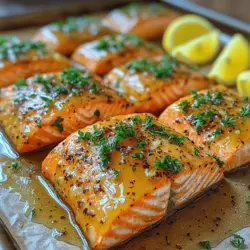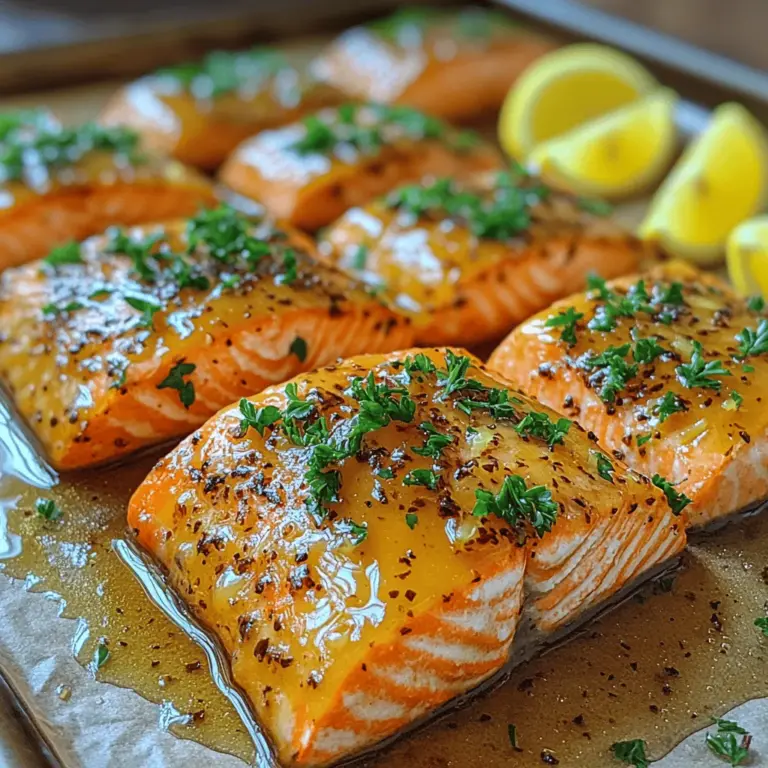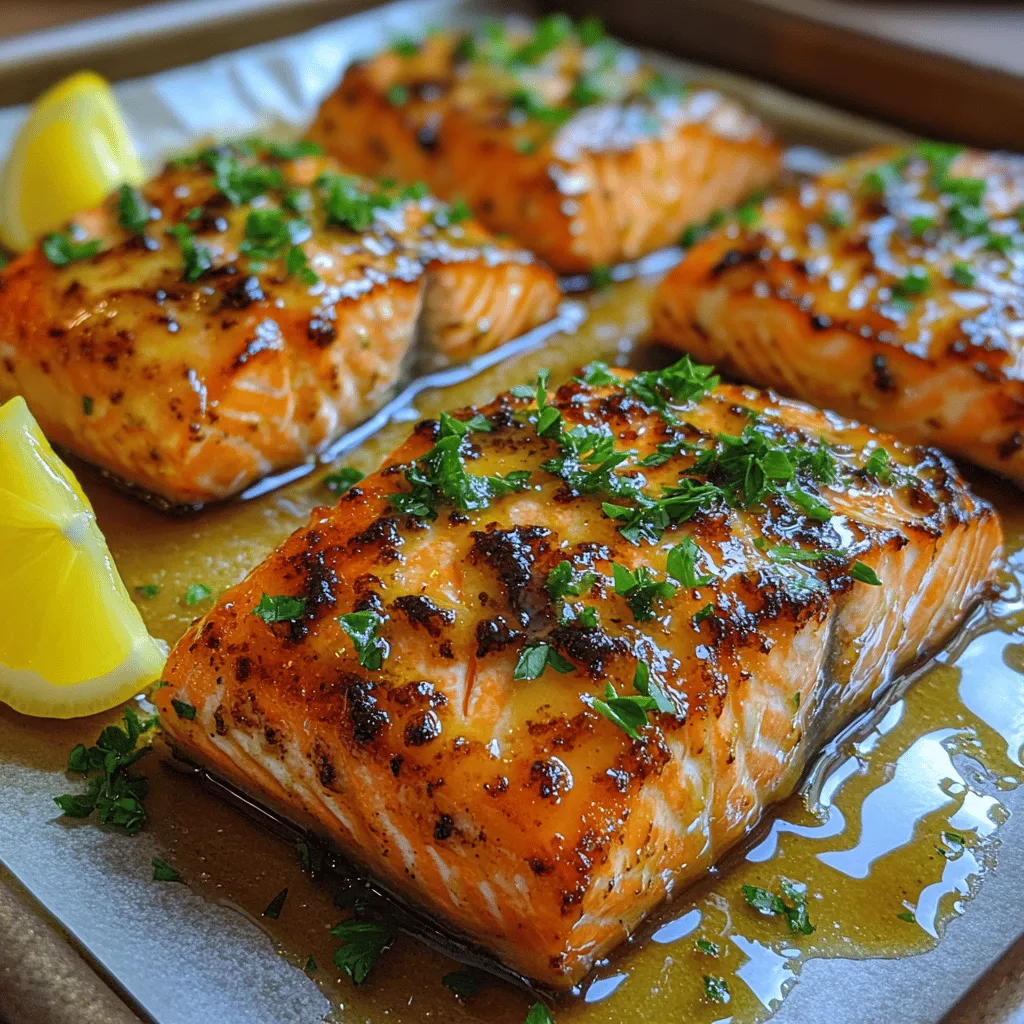Honey Butter Glazed Salmon: A Delicious Introduction
When it comes to quick and satisfying dinners, few dishes can compete with honey butter glazed salmon. This delightful seafood meal offers a perfect balance of sweet and savory flavors, making it a favorite among home cooks and gourmet chefs alike. The combination of tender salmon fillets glazed with a rich honey butter sauce creates a mouthwatering experience that is both comforting and sophisticated. Whether you’re preparing a weeknight dinner or hosting a special occasion, this dish promises to impress and delight.
Salmon is not just delicious; it’s also a powerhouse of nutrition. Rich in omega-3 fatty acids, high-quality protein, and essential vitamins, salmon is a staple in many health-conscious diets. Incorporating salmon into your meals not only supports heart health but also enhances brain function and contributes to overall well-being. This recipe takes advantage of salmon’s natural richness, allowing it to shine through the simple yet flavorful honey butter glaze.
The flavor profile of honey butter glazed salmon is a harmonious blend of sweet, savory, and slightly tangy elements. The honey adds a natural sweetness that beautifully complements the buttery richness, while the addition of soy sauce introduces a depth of umami that elevates the dish. With the subtle hint of garlic and the refreshing brightness from fresh lemon juice, each bite is a burst of flavor that tantalizes the taste buds.
The cooking method for this recipe is straightforward, involving baking the salmon after marinating it in the honey butter mixture. This technique ensures that the fish remains moist and flaky while absorbing all the delicious flavors from the glaze. As the salmon bakes, the glaze caramelizes slightly, creating a delectable crust that enhances both texture and taste.
Understanding the Ingredients
The foundation of any great dish lies in its ingredients, and honey butter glazed salmon is no exception. Each component serves a purpose, contributing to the overall flavor, texture, and nutritional value of the meal.
Salmon: The star of the dish, salmon is not only delicious but also packed with health benefits. Rich in omega-3 fatty acids, it supports heart health, reduces inflammation, and aids brain function. Additionally, salmon is an excellent source of high-quality protein and essential vitamins such as B12 and D. When choosing salmon, opt for wild-caught varieties when possible, as they tend to have a richer flavor and a better nutritional profile compared to farmed salmon.
Unsalted Butter: Butter plays a crucial role in this recipe, providing a rich and creamy flavor that enhances the overall taste of the dish. By using unsalted butter, you have greater control over the saltiness of the final product. It allows the natural flavors of the salmon and other ingredients to shine through without overpowering them.
Honey: This natural sweetener not only adds a hint of sweetness to the glaze but also offers various health benefits, including antioxidants and anti-inflammatory properties. The caramelization of honey during baking creates a beautiful glaze that enhances the salmon’s flavor and appearance.
Soy Sauce: A staple in many Asian cuisines, soy sauce introduces a savory umami flavor that complements the sweetness of the honey and the richness of the butter. It adds depth to the glaze and balances the dish’s flavor profile. For a gluten-free option, consider using tamari or coconut aminos.
Dijon Mustard: With its smooth texture and tangy flavor, Dijon mustard adds a layer of complexity to the glaze. It balances the sweetness of the honey and the richness of the butter, creating a well-rounded flavor that elevates the dish.
Garlic: This aromatic ingredient not only enhances the overall flavor but also adds a delightful fragrance to the dish. Garlic is known for its numerous health benefits, including immune-boosting properties and antioxidant effects. Fresh garlic will provide the best flavor, but garlic powder can be used in a pinch.
Fresh Lemon Juice: A squeeze of fresh lemon juice brightens up the dish, adding acidity that balances the richness of the butter and the sweetness of the honey. The citrus notes also enhance the natural flavors of the salmon, making each bite refreshing.
Spices: Salt, black pepper, and smoked paprika are essential for seasoning the salmon and enhancing its natural flavor. Smoked paprika adds a subtle smokiness that complements the richness of the fish. Seasoning the salmon properly is key to elevating the dish from good to great.
Garnishing with Parsley: A sprinkle of fresh parsley not only adds a pop of color to the dish but also enhances its flavor profile with a hint of earthiness. Fresh herbs are a simple way to elevate any meal, and parsley is no exception.
Serving Suggestions: Pair your honey butter glazed salmon with lemon wedges for an added burst of citrus flavor. Consider serving it alongside steamed vegetables, a fresh salad, or fluffy rice to create a well-rounded meal.
Preparing the Marinade
The marinade is where the magic happens. Marinating the salmon in the honey butter mixture allows the flavors to infuse deeply into the fish, resulting in a more flavorful and juicy final product. Here’s how to create the perfect honey butter marinade:
1. Combine Ingredients: In a mixing bowl, combine melted unsalted butter, honey, soy sauce, Dijon mustard, minced garlic, and fresh lemon juice. Whisk these ingredients together until they are well combined. The mixture should be smooth and slightly thick, allowing it to coat the salmon evenly.
2. Visual and Textural Qualities: The marinade should possess a glossy sheen from the melted butter and honey, with specks of garlic and mustard visible throughout. This visual appeal adds to the anticipation of the final dish.
3. Tips for Achieving the Perfect Consistency: If the marinade appears too thick, you can thin it out with a splash of additional lemon juice or a small amount of water. Conversely, if it’s too runny, a bit more honey or mustard can help achieve the desired consistency. The goal is to create a glaze that clings to the salmon without being overly watery.
Marinating the Salmon
Once your marinade is ready, it’s time to marinate the salmon. This step is crucial for maximizing flavor and ensuring the fish is tender and juicy.
The Science Behind Marinating: Marinating is a process that allows flavors to penetrate the proteins in the fish, resulting in a more flavorful dish. The acidity from the lemon juice and the enzymes in the salmon work together to break down the protein structure, making it more tender. Additionally, the salt in the soy sauce helps to draw moisture into the fish, enhancing its juiciness.
Recommended Marinating Times: For optimal flavor absorption, marinate the salmon for a minimum of 30 minutes. However, if time allows, marinating for 1 to 2 hours will yield even better results. Avoid marinating for too long—over three hours can start to break down the fish’s texture, resulting in a mushy consistency.
Best Practices for Marinating Fish: To ensure even flavor distribution, place the salmon fillets in a resealable plastic bag or a shallow dish, and pour the marinade over the top. Seal the bag or cover the dish, ensuring the salmon is well-coated. For best results, turn the salmon occasionally during the marinating process to encourage even infusion.
Baking the Salmon
After marinating, the next step is baking the salmon to perfection. Preheating the oven is a crucial step that should not be overlooked.
Preheating the Oven: Preheating your oven ensures that the salmon cooks evenly and at the right temperature from the start. This helps to maintain the fish’s natural moisture while allowing the honey butter glaze to caramelize beautifully. Aim for a baking temperature of 400°F (200°C), which will yield a perfectly cooked salmon with a slightly crispy exterior and a tender, flaky interior.
In the following parts of this article, we will delve deeper into the baking process, including tips for achieving the ideal level of doneness and suggestions for serving this delectable dish that will leave everyone asking for seconds. Stay tuned for the next steps in creating your honey butter glazed salmon masterpiece.
Preparing the Baking Sheet: Parchment Paper vs. Cooking Spray
When it comes to preparing your baking sheet for the Honey Butter Glazed Salmon, you have two excellent options: parchment paper or cooking spray. Both methods serve to prevent sticking, but they each have their own benefits.
Using parchment paper is a great choice if you want to ensure an easy cleanup. The salmon glides right off the paper without any residue, and you can simply toss the paper away once you’re done. It also helps in even cooking as it provides a slight barrier between the salmon and the direct heat of the baking sheet.
On the other hand, if you prefer the convenience of cooking spray, it can also be effective for a quick and straightforward approach. Just ensure that you apply an even layer to prevent the fillets from sticking. Whichever method you choose, the focus should be on ensuring the salmon cooks evenly and maintains its juicy texture.
Proper Placement of Salmon Fillets for Even Cooking
Once your baking sheet is ready, it’s crucial to place the salmon fillets correctly. Arrange the fillets skin-side down with enough space in between each piece. This spacing allows for optimal air circulation and ensures even cooking. If the fillets are too close together, they may not cook uniformly, leading to some pieces being overcooked while others remain undercooked.
Additionally, if your fillets are of varying thickness, place the thicker pieces on the outer edges of the baking sheet, where the heat is more intense, and the thinner pieces in the center. This strategic arrangement will help you achieve perfectly cooked salmon throughout.
Importance of Glazing While Baking for Moisture Retention
Glazing the salmon while it bakes is essential for retaining moisture. The honey butter glaze not only enhances the flavor but also forms a protective layer over the salmon, keeping it juicy and tender.
During the baking process, you should brush on the glaze about halfway through the cooking time. This allows the flavors to seep into the salmon and caramelize slightly, creating a deliciously sticky exterior. For the best results, apply more glaze during the last few minutes of baking to intensify the flavor and maintain a beautiful shiny finish.
Finishing Touches: Broiling for Perfection
Explanation of the Broiling Process and Its Benefits
After baking your salmon to a tender perfection, the finishing touch is broiling. Broiling is a cooking method that uses high heat from above, ideal for finishing dishes with a lovely caramelization. By placing your baked salmon under the broiler for just a few minutes, you can achieve an irresistible golden-brown crust that enhances both the visual appeal and flavor of the dish.
How Broiling Enhances the Caramelization of the Glaze
Broiling is particularly effective for caramelizing the honey butter glaze. As the intense heat works from above, it creates a delightful crust on the surface of the salmon, intensifying the sweet and savory notes of the glaze. This caramelization not only enhances the taste but also adds a beautiful contrast to the tender fish beneath.
Tips for Monitoring While Broiling to Prevent Burning
When broiling, vigilance is key. Salmon can go from perfectly caramelized to burnt in a matter of seconds. Here are some tips to ensure success:
1. Stay Close: Keep an eye on the salmon while it’s under the broiler. Check it every minute to monitor the browning process.
2. Adjust the Rack: Place your oven rack about 6 inches from the broiler element to control the intensity of the heat. This distance can help you achieve that perfect golden crust without burning the glaze.
3. Rotate the Pan: If your oven has hot spots, consider rotating the baking sheet halfway through broiling for even cooking.
Garnishing and Serving Suggestions
Importance of Presentation in Enhancing the Dining Experience
Presentation can elevate a meal from ordinary to extraordinary. For Honey Butter Glazed Salmon, consider garnishing with fresh herbs like parsley or dill to add a pop of color. Thinly sliced lemon or lime wedges also make an attractive addition, enhancing both the appearance and flavor of the dish.
Ideas for Side Dishes That Complement Honey Butter Glazed Salmon
To create a well-rounded meal, pair your salmon with sides that complement its rich flavors. Here are some excellent options:
– Roasted Vegetables: Carrots, asparagus, or Brussels sprouts roasted with olive oil, salt, and pepper.
– Quinoa Salad: A refreshing salad featuring quinoa, cucumber, cherry tomatoes, and a light vinaigrette.
– Garlic Mashed Potatoes: Creamy mashed potatoes with a hint of garlic pair beautifully with the sweetness of the glaze.
Pairing with Wines or Beverages to Elevate the Meal
Enhance your dining experience by pairing the Honey Butter Glazed Salmon with the right beverage. A crisp white wine, such as Sauvignon Blanc or Chardonnay, complements the sweetness of the honey glaze. If you prefer something non-alcoholic, a sparkling water with a splash of lemon or a refreshing iced tea can also be delightful choices.
Nutritional Analysis
Breakdown of the Nutritional Content Per Serving
When it comes to nutrition, Honey Butter Glazed Salmon offers a healthy balance of protein, healthy fats, and vitamins. Here’s a general breakdown of the nutritional content per serving (based on a 6 oz salmon fillet):
– Calories: Approximately 350
– Protein: 34g
– Fat: 20g (mostly healthy omega-3 fatty acids)
– Carbohydrates: 10g (from honey)
– Fiber: 0g
Health Benefits of the Specific Ingredients Used
Salmon is widely known for its numerous health benefits, primarily due to its high omega-3 fatty acid content, which supports heart health and reduces inflammation. Honey, on the other hand, offers natural sweetness and a range of antioxidants. Combined, they create a dish that is not only delicious but also beneficial for your overall health.
How This Dish Fits Into Various Dietary Lifestyles (e.g., Keto, Paleo)
Honey Butter Glazed Salmon fits well into various dietary lifestyles. For those following a keto diet, simply adjust the quantity of honey to lower the carbohydrate content. For paleo eaters, this dish is naturally compliant as it features whole, unprocessed ingredients.
Variations and Substitutions
Suggestions for Ingredient Substitutions for Dietary Restrictions
If you have dietary restrictions or preferences, there are several substitutions you can make without sacrificing flavor:
– Honey Alternatives: Use maple syrup or agave nectar for a vegan option.
– Butter Substitutes: Coconut oil or vegan butter can replace traditional butter for a dairy-free version.
– Salmon Alternatives: If salmon isn’t available, try this recipe with trout or even chicken breast for a different protein source.
Variations of the Recipe to Suit Different Palates (e.g., Spicy, Citrusy)
To suit various tastes, consider these variations:
– Spicy Glaze: Add a pinch of cayenne pepper or a dash of hot sauce to the honey butter mixture for a kick.
– Citrusy Twist: Incorporate the zest of an orange or lime into the glaze for a refreshing citrus flavor.
Cooking Methods: Grilling, Pan-searing, or Using an Air Fryer
While baking is a fantastic method for this dish, there are several other ways to prepare Honey Butter Glazed Salmon:
– Grilling: The grill adds a smoky flavor that enhances the glaze beautifully. Just ensure to reduce the heat to medium to avoid flare-ups.
– Pan-searing: Sear the salmon skin-side down in a hot skillet for a crispy exterior before glazing and finishing in the oven.
– Air Frying: For a quick preparation, air fry the salmon at 400°F for about 10-12 minutes, glazing it halfway through for a delicious finish.
Common Mistakes to Avoid
Overcooking Salmon: How to Tell When It’s Done
One of the most common pitfalls when cooking salmon is overcooking. Salmon is best served medium, with a slightly translucent center. A good rule of thumb is to cook salmon for about 4-6 minutes per half-inch of thickness. To check for doneness, use a fork to gently flake the thickest part of the fillet; if it flakes easily and is slightly opaque, it’s ready.
Mistakes in Marinating: Too Long vs. Too Short
Marinating salmon in the honey butter glaze for too long can lead to a mushy texture due to the sugars in the honey. Aim for a marinating time of 30 minutes to 2 hours for optimal flavor without compromising the fish’s integrity.
Not Using Enough Glaze During Cooking
One of the joys of this dish is the glaze. Ensure you are generous with the glaze during baking and broiling to maximize flavor. Remember that the glaze not only enhances taste but also contributes to the beautiful caramelization that makes this dish visually appealing.
Conclusion
Honey Butter Glazed Salmon is not just a dish; it’s an experience that brings together flavors, nutrition, and joy in cooking. Its versatility makes it suitable for various occasions, whether a casual weeknight dinner or an impressive feast for guests.
Try this recipe, and you’ll discover how easy it is to create a flavorful, healthy meal that everyone will love. Cooking is about sharing moments with loved ones, and this dish is sure to be a favorite at your table. Embrace the joy of cooking and savor the delightful flavors of Honey Butter Glazed Salmon!



